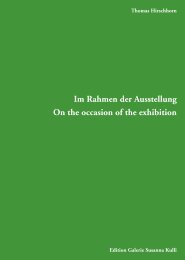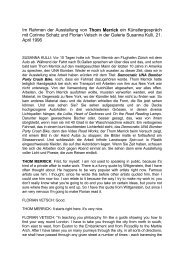Im Rahmen der Ausstellung - Galerie Susanna Kulli
Im Rahmen der Ausstellung - Galerie Susanna Kulli
Im Rahmen der Ausstellung - Galerie Susanna Kulli
You also want an ePaper? Increase the reach of your titles
YUMPU automatically turns print PDFs into web optimized ePapers that Google loves.
other domains. Poons started talking about overload when he felt that the information<br />
in his early paintings was escaping him anyway because he was into this<br />
optical thing when he was amazed by his own paintings, but they where escaping,<br />
and he had this feeling that overlaying activities at least on one painting would<br />
charge them with more and more significance. Because there would be more and<br />
more information. Interested in that he put more and more paint on the paintings,<br />
and then it started blobbing over the canvas itself, and when that was not<br />
enough he started sticking in bits and pieces he found around the studio so that it<br />
would really be luscious. In the pastry line they are the things that you just can’t<br />
get over if you start eating them. This notion is what I’m interested in. In the strategy<br />
of those shows it’s the fact that there is more and more information you can<br />
get, which is the case also in a very minimal situation, so in a way it’s a very literal<br />
strategy to what it is as opposed to the other version which is the one we started<br />
talking about: in a way with very little you achieve much. I’m not trying to say<br />
with a lot you achieve nothing. But in a way you achieve the same thing with<br />
different types of question marks.<br />
Bice Curiger: Talking about overload and history of art, another work you did<br />
comes to my mind, it was called «Don’t do it!». We went to see it together last<br />
week at Grenoble, and I think it was only one piece in three rooms which was used<br />
by the curator, Eric Troncy. He did something about which you might also say it<br />
is a forbidden act for a curator: he put two works of art together in interference.<br />
I’m interested in hearing your opinion, because those were your works which were<br />
put together. Perhaps you can describe it.<br />
John M Armle<strong>der</strong>: I’m the wrong person in that situation because it’s much more<br />
fun when the artist is annoyed and makes a scandal. It becomes heavier. And I<br />
think that is also the problem with Eric Troncy. In a way he was very wise in spite<br />
of his misdoing or his abuses, because in a way there was an agreement about it. I<br />
don’t work in the same way, but being an artist it’s true that you can get away with<br />
everything. I mean with your art already quite a bit. I never un<strong>der</strong>stood how we do<br />
get away, but when you use other artists’ works, some artists like it, some others<br />
don’t. But being an artist you don’t have the same kind of authority. Being a curator<br />
you have this problem as being the police service or intelligence service of the<br />
art world. So, of course, people fight against you in a very easy way. I dream of<br />
being abused by a curator. To get back to the «Pudding Overdose» situation, I used<br />
all the works of different artists and the worst situation, as I described before. And<br />
I do believe if Robert Ryman saw his blue paintings, I don’t think he would agree<br />
with the situation, although I’m sure that it happened to him before. I’m not sure<br />
that he really looked for that. I was very surprised doing that show that most of<br />
the artists who witnessed the situation and enjoyed it were conservative. Well, they





